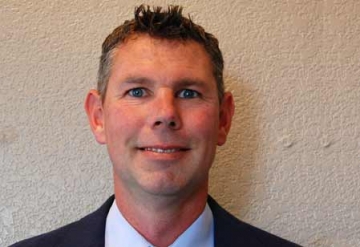THANK YOU FOR SUBSCRIBING

Port Construction: Using an Unmanned Boat for Uncharted Territory
Sarah Johnson, Field Engineer Manager, McCarthy Building Companies, Inc.

 Sarah Johnson, Field Engineer Manager, McCarthy Building Companies, Inc.
Sarah Johnson, Field Engineer Manager, McCarthy Building Companies, Inc.Demolishing a structure can be tricky, demolishing a failed dock that is partially submerged in 40 feet of murky water only to build a new one in its place, is extremely tricky. McCarthy Building Companies’ Marine group experienced this firsthand when we started the demolition of a 100-year-old dock at the Port of Beaumont (Beaumont, Texas). However, as with many things in life and construction, technology is coming to our aid.
“With all marine projects, one of the big risks is the unknown of what lies below the water. The Unmanned Survey Vehicle helps in efficiently providing clarity to this.”
McCarthy’s Marine Business Unit and McCarthy Mapping joined together to acquire McCarthy’s first hydrographic survey boat, also known as an unmanned survey vessel (USV). This boat is different from a conventional man-operated survey boat because it is remotely operated and only five feet long and three feet wide. The benefit of having a smaller, remote-controlled survey boat is safety and access to tight areas.
 Conventional survey boats are operated with a crew on the boat and much of the construction working equipment (crane barges, tugboats, etc.) needs to be moved out of the way to get an accurate scan. With the remote boat, we are able to deploy the boat and scan the site from a safe distance on land, removing the safety risks of working on the water. We are also able to access much tighter spaces than with a conventional survey boat. We can maneuver between work vessels to achieve a scan of the work area without having to move our large equipment. We are also able to survey between existing structures and in depths as shallow as two feet.
Conventional survey boats are operated with a crew on the boat and much of the construction working equipment (crane barges, tugboats, etc.) needs to be moved out of the way to get an accurate scan. With the remote boat, we are able to deploy the boat and scan the site from a safe distance on land, removing the safety risks of working on the water. We are also able to access much tighter spaces than with a conventional survey boat. We can maneuver between work vessels to achieve a scan of the work area without having to move our large equipment. We are also able to survey between existing structures and in depths as shallow as two feet.

The USV uses the same sonar technology as a conventional survey vessel - a multibeam echo sounder which sends out sound waves across the waterbody mudline. As the beams are bounced from the mudline back to the boat, data is collected and viewed in real-time on a landside computer. To determine the boat’s position the USV is equipped with two GPS rovers. The USV is also equipped with a sound velocity probe which reports the density, salinity, temperature, and conductivity of the water – all of which impact how fast sound waves travel through water so the data it collects is more accurate. Within 24 hours of processing time, the USV provides a complete map of the sea floor.
McCarthy has employed the USV since September 2022 and it has significantly impacted our marine projects. So far, we have been able to use the USV to scan for obstructions, identify slope angles, and measure seafloor depths.
• At the Port of Beaumont Main Street Terminal 1 project, we are demolishing a century-old dock, along with others, that is partially collapsed with more than half of the structures underwater in zero visibility. We knew about beams and miscellaneous concrete debris underwater, but the USV has helped pinpoint their exact location for easy extraction.
 After we scanned the site with the USV, we input the data into a GPS-enabled crane barge and removed up to 500-feet long concrete wall sections. The USV was also able to locate an existing timber bulkhead that obstructed the location of the new pile foundation. Our team was able to use this information and adjust the new pile location without destroying the backlands structures. The USV also recorded data to determine the quantities of slope protection needed.
After we scanned the site with the USV, we input the data into a GPS-enabled crane barge and removed up to 500-feet long concrete wall sections. The USV was also able to locate an existing timber bulkhead that obstructed the location of the new pile foundation. Our team was able to use this information and adjust the new pile location without destroying the backlands structures. The USV also recorded data to determine the quantities of slope protection needed.
• At the Port Freeport Velasco Berth 8 project, for which we constructed 925 feet of berth extension, we scanned the mechanically dredged toe trench to confirm it is at the correct depth per our plan drawings. We have also used these scans to determine quantities of riprap needed for the toe trench to protect it from ship propellers.
With all marine projects, one of the big risks is the unknown of what lies below the water. The USV helps in efficiently providing clarity to this. We are able to quickly schedule hydrographic surveys of our projects and provide data within the same day. With a USV scan costing about one-fourth of a conventional survey boat, the cost savings of the USV make scanning smaller areas and getting ahead of work easier.
Read Also
Development of the Logistics Warehousing Market in Brazil
Driving Innovation and Preserving Tradition
Operational Leadership VS Field Leadership in the Utility Construction Business
People-First Innovation: Developing Virtual Design and Construction (VDC) Training Programs to Empower Field Team Members
Sustainable Projects: Aligning Business and Purpose in Latin America
Engage Smarter: Why Constraints Matter More Than Hazards

 Copyright © 2025 All Rights Reserved | by:
Copyright © 2025 All Rights Reserved | by: Construction Tech Review
| Subscribe | About us | Sitemap| Editorial Policy| Feedback Policy














